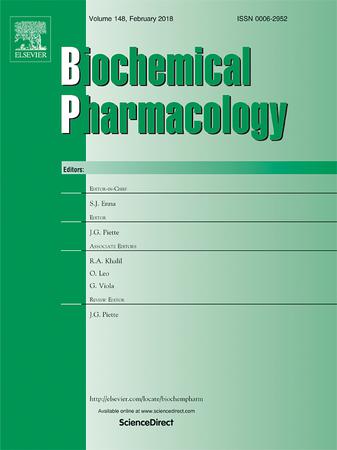基于纳米颗粒的胰腺癌治疗策略的突破。
IF 5.3
2区 医学
Q1 PHARMACOLOGY & PHARMACY
引用次数: 0
摘要
胰腺导管腺癌(Pancreatic ductal adencarcinoma, PDAC)是世界范围内最致命的癌症之一,主要原因是其异质性高、耐药和诊断晚,5年生存率不到10%。这种惨淡的预后促进了开发更有效治疗方法的策略。在过去的几十年里,基于纳米颗粒的策略作为一个巨大的机遇出现了,因为它们可以增强药物传递和促进控制释放,比传统治疗方案的副作用更小。此外,纳米颗粒通常可以修饰为针对特定细胞或实现药物持续释放到肿瘤中。然而,很少有基于纳米颗粒的治疗方法被临床批准。到目前为止,美国食品和药物管理局(FDA)和欧洲药品管理局(EMA)只批准了两种具体用于胰腺癌治疗的纳米制剂。纳米颗粒的临床转化仍然是现代医学的一个挑战,特别是胰腺癌治疗,因为疾病的复杂性,以及缺乏在临床相关的体外和体内模型中进行的研究。在这篇综述中,我们总结了最近在PDAC中使用纳米颗粒为基础的配方的临床试验,给出了不同类型纳米颗粒的使用背景和该领域的最新进展。本文章由计算机程序翻译,如有差异,请以英文原文为准。

Breakthroughs in nanoparticle-based strategies for pancreatic cancer therapy
Pancreatic ductal adenocarcinoma (PDAC) is one of the deadliest cancers worldwide, mainly due to its high heterogeneity, resistance to therapy and late diagnosis, with a 5-year survival rate of less than 10%. This dismal prognosis has promoted strategies to develop more effective treatments. Nanoparticle-based strategies have emerged, in the last decades, as a great opportunity because they can enhance drug delivery and promote controlled release, presenting lower side effects than conventional therapeutic regimens. Moreover, nanoparticles can often be modified to target specific cells or to achieve a sustained release of the drugs into the tumor. However, very few nanoparticle-based therapies are clinically approved. Concretely for pancreatic cancer treatment only two nanoformulations have been approved by the US Food and Drug Administration (FDA) and the European Medicines Agency (EMA) so far. Clinical translation of nanoparticles remains a challenge for modern medicine, and in particular for pancreatic cancer therapy, because of the complexity of the disease, and a lack of studies been performed in clinically relevant in vitro and in vivo models. In this review, we have summarized the most recent clinical trials using nanoparticle-based formulations in PDAC, giving a small context of the diverse types of nanoparticles employed and the most recent advancements in the field.
求助全文
通过发布文献求助,成功后即可免费获取论文全文。
去求助
来源期刊

Biochemical pharmacology
医学-药学
CiteScore
10.30
自引率
1.70%
发文量
420
审稿时长
17 days
期刊介绍:
Biochemical Pharmacology publishes original research findings, Commentaries and review articles related to the elucidation of cellular and tissue function(s) at the biochemical and molecular levels, the modification of cellular phenotype(s) by genetic, transcriptional/translational or drug/compound-induced modifications, as well as the pharmacodynamics and pharmacokinetics of xenobiotics and drugs, the latter including both small molecules and biologics.
The journal''s target audience includes scientists engaged in the identification and study of the mechanisms of action of xenobiotics, biologics and drugs and in the drug discovery and development process.
All areas of cellular biology and cellular, tissue/organ and whole animal pharmacology fall within the scope of the journal. Drug classes covered include anti-infectives, anti-inflammatory agents, chemotherapeutics, cardiovascular, endocrinological, immunological, metabolic, neurological and psychiatric drugs, as well as research on drug metabolism and kinetics. While medicinal chemistry is a topic of complimentary interest, manuscripts in this area must contain sufficient biological data to characterize pharmacologically the compounds reported. Submissions describing work focused predominately on chemical synthesis and molecular modeling will not be considered for review.
While particular emphasis is placed on reporting the results of molecular and biochemical studies, research involving the use of tissue and animal models of human pathophysiology and toxicology is of interest to the extent that it helps define drug mechanisms of action, safety and efficacy.
 求助内容:
求助内容: 应助结果提醒方式:
应助结果提醒方式:


